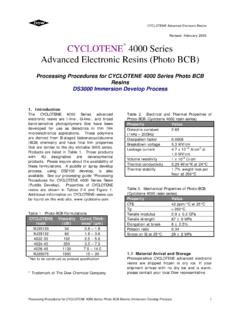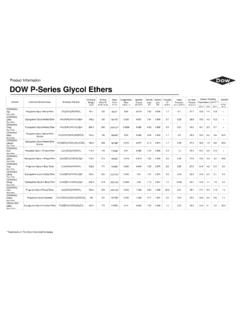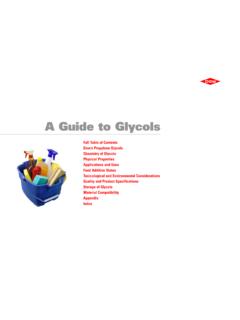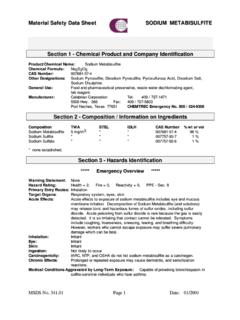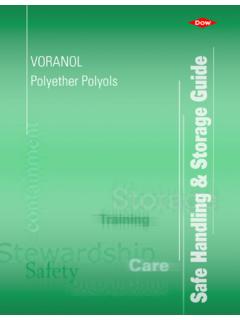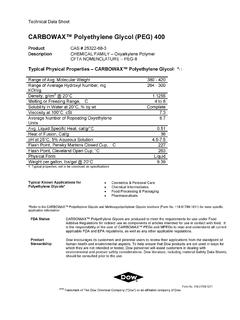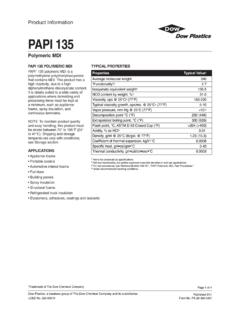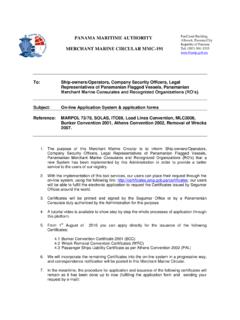Transcription of Product Safety Assessment METATIN Catalyst S-26 …
1 Created: March 9, 2011 The Dow Chemical Company Page 1 of 6 Product Safety Assessment METATIN Catalyst S-26 ( stannous octoate ) Product Safety Assessment documents are available at Select a Topic: Names Product Overview Manufacture of Product Product Description Product Uses Exposure Potential Health Information Environmental Information Physical Hazard Information Regulatory Information Additional Information References Names METATIN Catalyst S-26 METATIN Katalysator S-26 CAS No. 301-10-0 Tin bis(2-ethylhexanoate) stannous octoate Tin bis(2-ethylhexoate) Bis(2-ethylhexanoic acid), tin(II) salt Tin EHA 2-Ethylhxanoic acid, tin (II) salt Back to top Product Overview METATIN Catalyst S-26 ( stannous octoate ) is a clear to pale yellow, viscous liquid with a mild ,2 For further details, see Product Description. METATIN Catalyst S-26 is primarily used to promote crosslinking in the production of rigid, semi-rigid, and flexible polyurethane foams, and as a Catalyst in the production of polyurethane, silicone, and other ,4 For further details, see Product Uses.
2 Exposure to METATIN Catalyst S-26 is possible in industrial applications. The use of engineering controls and personal protective equipment, in conjunction with occupational exposure limits, have been established to minimize exposure in workplace settings. Consumer exposure is possible as this Product can be incorporated into consumer products such as paints and ,6 For further details, see Exposure Potential. Eye or skin contact can be irritating. Skin contact may cause sensitization or allergic reactions. Mutagenic, teratogenic, or birth defects have been reported in animal ,8 For further details, see Health Information. METATIN Catalyst S-26 is considered insoluble in water, toxic to aquatic organisms, and may cause long-term adverse effects in the aquatic environment. Being an ionic salt, this material dissociates into its tin(II) and 2-ethylhexanoic acid component ions in water. 2-Ethylhexanoic acid is readily biodegradable, and thus will be rapidly and completely degraded in water and soil, and during biological Tin(II) will oxidize to tin(IV) in the environment, and will become part of the naturally-occurring pool of insoluble tin(IV) minerals in soil, water, and sediments.
3 For further details, see Environmental Information. METATIN Catalyst S-26 is not combustible and is stable under normal storage and operating conditions. During a fire, irritating and highly toxic gases and/or fumes, such as carbon oxides, Trademark of The Dow Chemical Company ( Dow ) or an affiliated company of Dow Product Safety Assessment : METATIN Catalyst S-26 ( stannous octoate ) Created: March 9, 2011 The Dow Chemical Company Page 2 of 6 may be generated during combustion or ,11 For further details, see Physical Hazard Information. Back to top Manufacture of Product Capacity Dow produces 4,000 metric tonnes ( million pounds) of METATIN Catalyst S-26 per year at facilities in Buchs, Switzerland. Process stannous octoate is produced by dissolving tin metal in hydrochloric acid (HCl) to generate liquid stannous chloride (SnCl2). stannous chloride is then reacted with sodium hydroxide (NaOH) and the resulting SnO is reacted further with 2-ethylhexanoic acid forming stannous octoate as the final Product .
4 The structure is shown below. COO-COO-Sn+2 stannous octoate Back to top Product Description12,13,14 METATIN Catalyst S-26 is a clear to pale yellow viscous liquid with a mild odor. It is the stannous (tin[II]) salt of 2-ethylhexanoic acid (EHA) and readily dissociates in water to the corresponding metal cation Sn+2 and 2-ethylhexanoic acid. Back to top Product Uses15,16,17 METATIN Catalyst S-26 acts as a Catalyst by delivering a metal ion (tin[II]) to a chemical reaction. It can be used in two-component coating products, paints, or do-it-yourself epoxy adhesives. Two principal uses are: To promote cross-linking in the production of rigid, semi-rigid, and flexible polyurethane foams. As a Catalyst in the production of polyurethane, silicone, and other polymers. Back to top Exposure Potential18,19 METATIN Catalyst S-26 is used in the production of industrial and consumer products. Based on the uses for this Catalyst , the public could be exposed through: Workplace exposure Exposure can occur either in a facility that manufactures METATIN Catalyst S-26 or in facilities that use this Product .
5 This Catalyst is produced, distributed, and stored in closed systems. Those working with this Product in manufacturing operations could be exposed during maintenance, sampling, testing, or other procedures. Each manufacturing facility should have a thorough training program for employees and appropriate work processes, ventilation, and Safety equipment in place to limit exposure. See Health Information. Trademark of The Dow Chemical Company ( Dow ) or an affiliated company of Dow Product Safety Assessment : METATIN Catalyst S-26 ( stannous octoate ) Created: March 9, 2011 The Dow Chemical Company Page 3 of 6 Consumer exposure to products containing METATIN Catalyst S-26 Consumer products such as two-component coatings and do-it-yourself epoxy adhesives may contain low levels of METATIN Catalyst S-26 (typically less than 1% by weight). Consumer exposures are very low due to the low concentration and infrequent use of these products.
6 See Health Information. Environmental releases In the event of a spill, the focus is on containing the spill to prevent contamination of soil and surface or ground water. Small spills should be absorbed with inert materials such as sand or soil and disposed of as hazardous waste. If released to the environment, METATIN Catalyst S-26 is readily biodegradable and unlikely to bioconcentrate (accumulate in the food chain). This material is not likely to adsorb to soil or sediment. See Environmental, Health, and Physical Hazard Information. Large release Industrial spills or releases are infrequent and generally contained. If a large spill does occur, the material should be captured, collected, and reprocessed or disposed of according to applicable governmental requirements. Ensure than adequate ventilation exists. Notify authorities if a spill has entered a waterway or sewer or has contaminated soil or vegetation. See Environmental, Health, and Physical Hazard Information.
7 In case of fire Deny any unnecessary entry into the area. Use an extinguisher that is suitable for the surrounding material to fight the fire. Firefighters should wear positive-pressure, self-contained breathing apparatus (SCBA) and protective firefighting clothing. Hazardous vapors may be released in a fire. Follow emergency procedures carefully. See Environmental, Health, and Physical Hazard Information. For more information, request the Safety Data Sheet from the Dow Customer Information Group. Back to top Health Information20 Eye contact Contact may cause irritation or serious damage to eyes. Skin contact Contact may cause irritation or serious allergic reaction or skin sensitization. Inhalation Inhalation may be irritating to the nose, throat, and respiratory tract. Other stannous octoate is considered reprotoxic Category 2 (damaging to the reproductive process) based on developmental For more information, request the Safety Data Sheet from the Dow Customer Information Group.
8 Back to top Environmental Information22 METATIN Catalyst S-26 is an ionic salt that dissociates in water at most pH conditions and does not readily evaporate. If released to the environment, the components are likely to become dissolved and remain associated with the water compartment. METATIN Catalyst S-26 has a low potential for adsorption to organic matter (soil or sediment). The 2-ethylhexanoic acid component is readily biodegradable, and will be rapidly degraded in water and soil, and during biological wastewater treatment. The tin(II) component will be oxidized to tin(IV) species, and ultimately become part of the naturally-occurring pool of insoluble tin(IV) minerals in soil, water, and sediments. Standard wastewater-treatment practices are employed during Product manufacture and by customers during processing. These practices neutralize the acidic nature of the Product , and wastewater pre-treatment technologies such as metal precipitation and/or chelation techniques are utilized to comply with established local and state limits prior to discharge to a Trademark of The Dow Chemical Company ( Dow ) or an affiliated company of Dow Product Safety Assessment : METATIN Catalyst S-26 ( stannous octoate ) Created: March 9, 2011 The Dow Chemical Company Page 4 of 6 wastewater treatment plant.
9 These limits and practices are designed to protect aquatic organisms and the environment. For more information, request the Safety Data Sheet from the Dow Customer Information Group. Back to top Physical Hazard Information23,24 METATIN Catalyst S-26 is not combustible and is stable under normal storage and use conditions. The Product should be stored in the original container in cool, dry, well-ventilated area out of direct sunlight and away from incompatible materials. During a fire, irritating and highly toxic gases and/or fumes, such as carbon oxides, may be generated during combustion or decomposition. For more information, request the Safety Data Sheet from the Dow Customer Information Group. Back to top Regulatory Information Regulations may exist that govern the manufacture, sale, transportation, use, and/or disposal of METATIN Catalyst S-26. These regulations may vary by city, state, country, or geographic region. Information may be found by consulting the relevant Safety Data Sheet, Technical Data Sheet, or Contact Us.
10 Back to top Additional Information Safety Data Sheet (Request at ) Contact Us ( ) Tin bis(2-ethylhexanoate), EC Number: 206-108-6, CAS: 310-10-0, Chemical Safety Report, Rohm and Haas Europe Trading ApS, , August 27, 2010 (Request at ) Tin bis(2-Ethylhexanoate), CAS No. 301-10-0, The Metal Carboxylates Coalition, Final Submittal, High Production Volume (HPV) Chemical Challenge Program, December 2007 ( ) METATIN Catalyst S-26, ACIMA AG, a Rohm and Haas Company, September 15, 2009 (Request at ) Back to top References 1 Tin bis(2-ethylhexanoate), EC Number: 206-108-6, CAS: 310-10-0, Chemical Safety Report, Rohm and Haas Europe Trading ApS, , August 27, 2010, page 3. 2 METATIN Katalysator S-26 Safety Data Sheet, Rohm and Haas Company, November 27, 2008, pages 1 and 3 4. 3 Tin bis(2-Ethylhexanoate), CAS No. 301-10-0, Metal Carboxylates Coalition, Final Submittal, High Production Volume (HPV) Chemical Challenge Program, December 2007, page 1.
